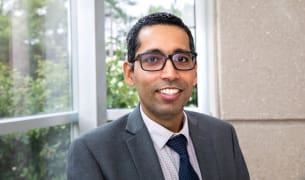 Anupam Jhingran, Ph.D. is a technology manager at the MSU Innovation Center overseeing inventions in Life Sciences, which includes human therapeutics, veterinary medicine and research tools. His role is multifaceted, and includes engaging with faculty and research scientists, Intellectual Property (IP) attorneys, business partners and entrepreneurs across campus.
Anupam Jhingran, Ph.D. is a technology manager at the MSU Innovation Center overseeing inventions in Life Sciences, which includes human therapeutics, veterinary medicine and research tools. His role is multifaceted, and includes engaging with faculty and research scientists, Intellectual Property (IP) attorneys, business partners and entrepreneurs across campus.
Working with university researchers, Jhingran helps identify marketable inventions for commercialization. For those inventions which are patentable, he works with outside patent counsel to strategize the scope and timing for filing the patent applications. Once a patent application is filed, Jhingran begins connecting with industry leaders to identify a business partner to develop the inventions into products or services for the commercial market, thereby impacting and benefiting the public.
“Being a part of the innovation ecosystem is very rewarding as it presents opportunities to contribute towards the economic and societal impact of our university research,” Jhingran said.
Jhingran completed a Ph.D. in molecular parasitology and conducted postdoctoral research in fungal immunology at Memorial Sloan Kettering Cancer Center. He also has a master’s degree in biomedical sciences from Delhi, India.
Jhingran began his career in technology transfer at Cornell University as a technology transfer intern, assisting in the management of institutional IP. Soon after, he accepted a position at Stony Brook University in its technology transfer office. Jhingran joined the MSU Innovation Center in 2019.
Outside of the office, Jhingran enjoys spending time with his family, especially at Potter Park Zoo. His other hobbies include playing Tabla, a pair of musical drums, originally from the Indian subcontinent.
MSU research generates a diverse set of technologies, providing Jhingran with the opportunities to help bring unique innovations to the greater public.
“I am particularly interested in gaining experience in commercializing software and artificial intelligence-based inventions in the life science sectors” he said. “There is a need, and we want to help answer that call.”
